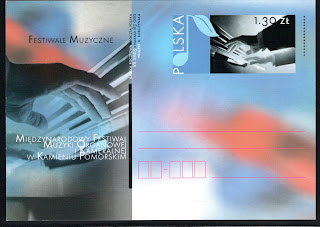This envelop is rather unremarkable save for the postmark. And it is somewhat blurry. It seems the Music Lovers Circle of the Romanian Philatelic Society was busy in 1990, as this cover looks much like others they prepared that year. Their name does not appear on this cover, but the looks is strikingly familiar.
ziua internationala a muzicii (the international day of music)
October 1 1990
The line above Croner's name is blurred but a couple of the words seem to read composition/composer and organist. His dates are given 1655-1740. I have never heard of Croner before, but was able to find a couple of websites that had information about him and his compositions
http://www.musicstamps.com/mjoomla/index.php/c/1285-croner-daniel
A review of a recording that includes some of his works:
http://pamelahickmansblog.blogspot.com/2014/11/romanian-organist-and-harpsichordist.html
Daniel Croner (1656-1740), apparently a native of Kronstadt (now Brasov, Romania), a theologian and composer of organ music, completed four books of organ tablatures. A scribe, he was known to have spent four years copying works from the Brasov manuscript, mostly for his own use and for the Lutheran service. The Magnificat 8 toni, from the Brasov manuscript, consists of five verses, based on a traditional cantus firmus, probably originally alternating with sung chant. In four of them, the cantus is presented in long note values in the pedals, with the two manuals creating contrapuntal lines boasting much imitation. Garai’s playing offered an informed glimpse into the articulate and imaginative style of German pre-Bach organ composition, conservative and unpretentious in nature, yet innovative and certainly not lacking in dissonance.
A concert performer comments on some of the works he performs, including b Croner:
http://regizene.ro/html/2017/en/index.php/artist/fazakaz-adam-sandor-ro/
Daniel Croner, born in Brașov, was a Transylvanian Saxon composer, organist and theologian. His legacy includes several manuscripts which contain shorter pieces, such as the three compositions included in the programme: a toccata in the South German style, a bicinium-adaptation of the chorale “Ich ruf zu dir Herr Jesu Christ” (“I call to you, Lord Jesus Christ“), a fugue for four voices.
https://www.worldcat.org/identities/lccn-n90622695/
Since I had not heard of him before, I was curious if Croner had any organ music available. A WorldCat search revealed some possibilities. I have requested on title from Duke University.
Daniel Croner has an association with the Marienkirche or Schwarze Kirche (Black Church) in Kronstadt. The facade of the current instrument, by Buchholz in the late 1800's (itself the subject of a Romanian stamp in recent years) is not that shown in the postmark above. There was, however, an instrument prior to this which may be the basis for the postmark. This article gives a great deal of information about the organs' history at this church.
The stamp on the cover is a very common 1.50 lei stamp from the 1982 "Popular Arts" (folk art) series, showing a (rather ornate) wooden scoop. Scott #3104


























